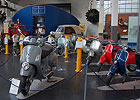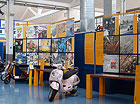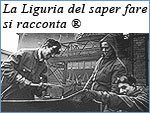 An interview with Tommaso Fanfani Chairman of the Piaggio Foundation An interview with Tommaso Fanfani Chairman of the Piaggio Foundation
by Giuseppe Paletta
|
| Enlarge text |
 |
 |
|
The Initial Motivations
Between Public and Private
The governance
The Relationship between Foundation and Business
Bibliography
G.P: Okay, that’s clear. Now, let’s go back to the prospect of a new place for the museum and to the question of the effectiveness of the company. T.F: Effective relations between the Foundation and business is a normal condition. In some periods it becomes everyday routine. Especially recently, everything we do, every event the foundation participates in is shared with the company and there is a direct link between the Piaggio press office and the public relations and communications manager of the company. The event, project or initiative may originate from us or from the company.  For example, the company organizes conventions in different periods of the year, or perhaps the presentation of products. There are meetings with the dealers and internal discussions as well as operational meetings among structures, divisions and sectors There are also training sessions. Sometimes it’s simply a matter of availability of premises to hold a meeting; other times collaboration is more complex; for example, organizing the iconographic research for publications managed by Piaggio in cooperation with various publishing houses. Occasions for shared effectiveness are frequent whether it concerns the content of the cultural project, or the content of the archives. I think that the cyclic nature of the cooperation –apart from practical issues like the organization of events, is the result of the sensitivity of managers who may or may not consider the Foundation, the archives and the museum as potentially significant containers for strategic, managerial and organizational objectives. The company frequently asks us questions on the development of a design or business communication, and sometimes consults us about the events organized a product launch. A recent example will explain what I mean; the Calessino is a new Piaggio product that will be soon launched on the market.The name of this last generation product comes from the museum where there is the Ape Calessino of 1956. They asked us who this name belonged to in order to reuse it. Commercial interaction with the company is strong and we are solicited in this direction every day. Maybe this is also the secret behind the company’s support. However, I seriously believe that as long as the entrepreneur is convinced of the corporate social function and therefore believes that a cultural project is a way to interpret the expectations of the shareholders, everything is fine. If, on the other hand, the entrepreneur has no sensitivity towards social factors, the return on supporting cultural initiatives in terms of image, expertise, and services for the production itself. When experts of the Centro stile dell’impresa come here to look at some photographs, the design of the 1940s and 50s, maybe looking for a new idea or an inspiration, this is a service that the Foundation’s historical archives provides for the company.
For example, the company organizes conventions in different periods of the year, or perhaps the presentation of products. There are meetings with the dealers and internal discussions as well as operational meetings among structures, divisions and sectors There are also training sessions. Sometimes it’s simply a matter of availability of premises to hold a meeting; other times collaboration is more complex; for example, organizing the iconographic research for publications managed by Piaggio in cooperation with various publishing houses. Occasions for shared effectiveness are frequent whether it concerns the content of the cultural project, or the content of the archives. I think that the cyclic nature of the cooperation –apart from practical issues like the organization of events, is the result of the sensitivity of managers who may or may not consider the Foundation, the archives and the museum as potentially significant containers for strategic, managerial and organizational objectives. The company frequently asks us questions on the development of a design or business communication, and sometimes consults us about the events organized a product launch. A recent example will explain what I mean; the Calessino is a new Piaggio product that will be soon launched on the market.The name of this last generation product comes from the museum where there is the Ape Calessino of 1956. They asked us who this name belonged to in order to reuse it. Commercial interaction with the company is strong and we are solicited in this direction every day. Maybe this is also the secret behind the company’s support. However, I seriously believe that as long as the entrepreneur is convinced of the corporate social function and therefore believes that a cultural project is a way to interpret the expectations of the shareholders, everything is fine. If, on the other hand, the entrepreneur has no sensitivity towards social factors, the return on supporting cultural initiatives in terms of image, expertise, and services for the production itself. When experts of the Centro stile dell’impresa come here to look at some photographs, the design of the 1940s and 50s, maybe looking for a new idea or an inspiration, this is a service that the Foundation’s historical archives provides for the company.
 G.P: So, while the starting of the project arose from the empathy between yourself and Giovanni Agnelli, the development that you refer to allows the project to multiply its links with the operative parts of the business. This seems even more important considering a large company like Piaggio whose several divisions can test the utility of the project directly. Together with the political link remains at the upper level, a network of functional relations has grown throughout the operative nerve centers of the company, which consider the Foundation as their own. T.F: That’s correct. However, the underlying premise stays the same: the fruitfulness of the relation between cultural project and business, between Foundation and company is contingent upon on the sensitivity of the people with decision-making power. The life of the cultural project depends on the choices of the top management, on their cultural sensitivity and vision. The synergy among Foundation, museum, archives and business allows the Foundation to carry out a service at multiple levels. We offer a productive atmosphere to present a new project, to discuss strategies for marketing a product, to meet young design talents and so on. So there is positive interaction between the business and the Foundation that can bring mutual benefits and consolidate the natural link between the company and its cultural foundation. It hasn’t always been easy, especially when the company was struggling in the market, but the existence of the Foundation was never questioned. I think this is because the company has gained from this interactivity. G.P: We keep referring to the company as if it were a monolith. On the contrary, it hosts a lot of actors who don’t necessarily agree with each other all the time: entrepreneurs, managers, technicians, workers. Can all these internal stakeholders recognise themselves in the museum? T.F: Yes, I definitely think so, because the sense of belonging is felt at all levels, as much by the company as by the employees and their families. When Piaggio produces and invests millions for a new project that reminds us of a vehicle seen in the museum, we recall not only the history of the company, but also of the products themselves. As far as the employees and the outside world is concerned, the Foundation and the museum are frequently considered sacred places.
G.P: So, while the starting of the project arose from the empathy between yourself and Giovanni Agnelli, the development that you refer to allows the project to multiply its links with the operative parts of the business. This seems even more important considering a large company like Piaggio whose several divisions can test the utility of the project directly. Together with the political link remains at the upper level, a network of functional relations has grown throughout the operative nerve centers of the company, which consider the Foundation as their own. T.F: That’s correct. However, the underlying premise stays the same: the fruitfulness of the relation between cultural project and business, between Foundation and company is contingent upon on the sensitivity of the people with decision-making power. The life of the cultural project depends on the choices of the top management, on their cultural sensitivity and vision. The synergy among Foundation, museum, archives and business allows the Foundation to carry out a service at multiple levels. We offer a productive atmosphere to present a new project, to discuss strategies for marketing a product, to meet young design talents and so on. So there is positive interaction between the business and the Foundation that can bring mutual benefits and consolidate the natural link between the company and its cultural foundation. It hasn’t always been easy, especially when the company was struggling in the market, but the existence of the Foundation was never questioned. I think this is because the company has gained from this interactivity. G.P: We keep referring to the company as if it were a monolith. On the contrary, it hosts a lot of actors who don’t necessarily agree with each other all the time: entrepreneurs, managers, technicians, workers. Can all these internal stakeholders recognise themselves in the museum? T.F: Yes, I definitely think so, because the sense of belonging is felt at all levels, as much by the company as by the employees and their families. When Piaggio produces and invests millions for a new project that reminds us of a vehicle seen in the museum, we recall not only the history of the company, but also of the products themselves. As far as the employees and the outside world is concerned, the Foundation and the museum are frequently considered sacred places.  When Giovanni Alberto Agnelli died, there was a period of confusion – as I said before – about the cultural project and its continuation. While walking on the streets, people would ask me “When are you going to open the Piaggio museum? When will the Piaggio museum be ready?” This to say that this place and what it represents is a sense of identity not only for the memory but especially because it is a concrete demonstration of what we did together, of what can be done. Marc Bloch (a French historian) once said that the history doesn’t help to know the future, but to understand the present. I believe the Piaggio museum is a privileged place that gives recognition to all parts of the company and to the community that surrounds it. When the ratio between the population and employees is 26,000 to 13,000 (even if not all from Pontedera, strictly speaking), it’s clear that we are talking about a company town.
When Giovanni Alberto Agnelli died, there was a period of confusion – as I said before – about the cultural project and its continuation. While walking on the streets, people would ask me “When are you going to open the Piaggio museum? When will the Piaggio museum be ready?” This to say that this place and what it represents is a sense of identity not only for the memory but especially because it is a concrete demonstration of what we did together, of what can be done. Marc Bloch (a French historian) once said that the history doesn’t help to know the future, but to understand the present. I believe the Piaggio museum is a privileged place that gives recognition to all parts of the company and to the community that surrounds it. When the ratio between the population and employees is 26,000 to 13,000 (even if not all from Pontedera, strictly speaking), it’s clear that we are talking about a company town.
G.P: I’d like to tell you about something I saw at the Dalmine Archives. Last year, for the celebration of the centenary of the company, Carolina Lussana organized an exhibition with the photographs of the historical archives representing workers and asking the visitors to recognize the people and write their names next to the images. With this system, the worker/numbers as they frequently appear in business iconography became worker/people. The effect was overwhelming: the visitors debated, exclaimed aloud and were moved when they recognized grandparents, parents, or even themselves when they were young. On that occasion, Carolina Lussana used the business archives to increase the recognizability and stimulate the sense of belonging to the company through a cultural instrument. Does the Piaggio Foundation have plans for a similar initiative? T.F: Apart from Carolina’s ingenious idea, let’s say that the operative strategy of the Foundation has always been transversal, because here in Tuscany we are facilitated by the fact that social barriers are less marked than in Lombardy. I believe that this place as it is organized shows the versatility of the company. To tell the truth, I have never thought about it before, but I can say that here there are tensions, orientations, and very different ways of doing things. It’s an environment where the strongest players are the products themselves and the testimony of the historical moment: two elements that create a sort of balanced compensation. So, I believe that the Piaggio cultural project helped to make people understand the DNA of the company, but at the same time, it highlighted the identification with common work, which is the result of a cultural mentality that doesn’t consider differences of social classes. Then, as in all ‘heroic’ companies, meaning companies that managed to produce goods that lasted over the years and are still present on the market, their strength also lies in the fact that there is continuous contact between the engineer and the planner, the designer, the mechanic right down to the person who only looks after the oiling of the product. I hope I have answered your question. G.P: Yes, completely. My curiosity comes from the fact that I am familiar with more impersonal working environments where I come from and you have reminded me that here in Tuscany the social communication is more direct. Anyway, Lussana’s idea of interacting with the photographs was very effective. T.F: Extremely valuable. It’s a good idea. When we had the exhibition “Arte e lavoro”we included a section of photographs of the various trades and occupations in Piaggio: the turners, the plumbers and so on. But I want to tell you an episode to make you understand the particular relation between social classes in this company.  Piaggio is famous for its historical strikes, the ones of the 1950s or the early 1960s lasted several turbulent months. This is a company that, in the years after the war, had a lot of traditional authoritarian legacies; it was almost a military company for its kind of production.In 1964, during a violent strike, the workers pelted Enrico Piaggio’s house with stones and the members of its family couldn’t leave with their car because the workers overturned it, as also happened to Francesco Lanzara. But later in November, when an ambulance was seen leaving the offices because Enrico Piaggio had taken ill all of a sudden, and the news spread that the “boss” –who so much hated at that moment-- was in that ambulance, the strike ended immediately. When he died ten days later, the reaction of the workers and of the city was one of extraordinary participation. The photographs of Enrico Piaggio’s funeral are an impressive testimony: Thousands and thousands of people crowded the fields and the place of his private residence in Varrmista. This to say that, despite the strong unrest, the relationship, the link to the company prevails and the company belongs to everyone. Even more, if in 1945 D’Ascanio chose to imitate Uncle Scrooge McDuck and create the MP6, asking his technicians to work without pause on Saturday and Sunday, night and day, they did it. There are a lot of similar episodes that make it clear that the company is “the home base”. In living ‘shoulder to shoulder’, the concept of the company as a superior entity, the expectations, and the level of participation at Enrico Piaggio’s funeral are, in my opinion, important signs. And Piaggio is full of episodes like these.
Piaggio is famous for its historical strikes, the ones of the 1950s or the early 1960s lasted several turbulent months. This is a company that, in the years after the war, had a lot of traditional authoritarian legacies; it was almost a military company for its kind of production.In 1964, during a violent strike, the workers pelted Enrico Piaggio’s house with stones and the members of its family couldn’t leave with their car because the workers overturned it, as also happened to Francesco Lanzara. But later in November, when an ambulance was seen leaving the offices because Enrico Piaggio had taken ill all of a sudden, and the news spread that the “boss” –who so much hated at that moment-- was in that ambulance, the strike ended immediately. When he died ten days later, the reaction of the workers and of the city was one of extraordinary participation. The photographs of Enrico Piaggio’s funeral are an impressive testimony: Thousands and thousands of people crowded the fields and the place of his private residence in Varrmista. This to say that, despite the strong unrest, the relationship, the link to the company prevails and the company belongs to everyone. Even more, if in 1945 D’Ascanio chose to imitate Uncle Scrooge McDuck and create the MP6, asking his technicians to work without pause on Saturday and Sunday, night and day, they did it. There are a lot of similar episodes that make it clear that the company is “the home base”. In living ‘shoulder to shoulder’, the concept of the company as a superior entity, the expectations, and the level of participation at Enrico Piaggio’s funeral are, in my opinion, important signs. And Piaggio is full of episodes like these.

